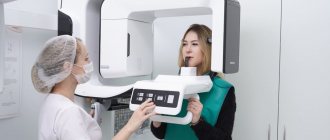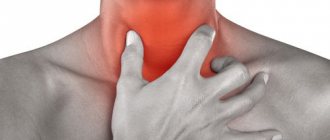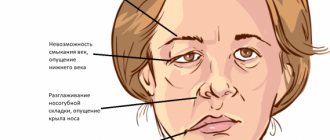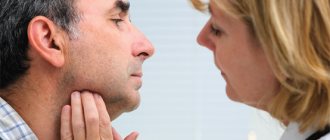Pain in the throat and ear is a clinical manifestation of a number of otolaryngological diseases, and much less often - neoplasms of a malignant nature. Most often it is one-sided and signals the presence of inflammatory processes occurring in the sinuses, tonsils, lymph nodes and larynx. Treatment of chronic sore throat is aimed at eliminating inflammatory processes and pain symptoms. For this, the otolaryngologist prescribes medications.
The otolaryngology department of CELT offers diagnosis and treatment of chronic ear pain. Our multidisciplinary clinic has been operating in the paid medical services market in Moscow for almost thirty years. Our specialists operate with international treatment standards and have everything necessary for accurate diagnosis and effective treatment in accordance with them.
At CELT you can consult an otorhinolaryngologist.
- Initial consultation – 3,000
- Repeated consultation – 2,000
Make an appointment
Causes of chronic pain in the throat and ear
Pain in the throat and ear, without or with fever, is one of the most common complaints of patients visiting an otolaryngologist. On average, about 15% of patients seek professional help. As already mentioned, most often the pain occurs on one side; There are also cases when it covers both sides.
The reasons for this phenomenon lie in pathological processes affecting several anatomical structures, but not necessarily. There are often cases when the pain radiates to the ear when the throat is affected. The features of human anatomy are such that the ear, throat, mouth and nose form a communicating system, interconnected by channels.
When inflammation develops in any of the organs, the process spreads through these channels, affecting other structures of the system - the organs of hearing and the pharynx - which provokes pain in the throat and ear. The patient may complain of a sore throat radiating to the ear - or, conversely, the appearance of pain in the organ of hearing and spreading to the throat. It also happens that the patient cannot accurately determine the source of pain.
Symptoms in the form of pain are characteristic of a wide range of pathological conditions, which you can learn about by reading our tables presented in the following sections.
Diagnosis of the disease
You should not overuse self-medication and adopt the experience of friends. Medical statistics show a huge number of examples of premature disability due to incorrect use of medications.
Groups of pharmaceuticals effective for inflammatory infectious diseases of the throat:
- antiseptic drugs;
- antiviral;
- combined agents - antiseptic and anesthetic.
- antiseptic drugs,
- antiviral,
- combined agents - antiseptic and anesthetic.
To determine what caused the condition to worsen, you should consult a doctor. You should not diagnose yourself at home, since you can make an incorrect diagnosis and prescribe inappropriate treatment, which will cause your health to worsen.
The doctor will interview the patient and find out his complaints. An external inspection will then be carried out. The doctor will look at the throat and examine the patient by palpation. Tests will be ordered if necessary.
To avoid the occurrence of pathology, it is recommended to carry out preventive measures on a regular basis.
Immunity should be strengthened. Hardening, daily exercises, and taking vitamins with food or in the form of special complexes will help with this. It is recommended to give up bad habits: smoking, alcohol, consuming various substances that are toxic to the body. Healthy sleep and sufficient rest time are important. It is necessary to walk in the fresh air. To prevent pathological conditions, you can drink herbal decoctions in courses. It is recommended to consult a doctor to select appropriate medicinal plants.
During the cold season, the head and neck should not be allowed to become hypothermic. It should be remembered that you can get sick not only in winter, but also in summer. During the hot season, you should not drink too many cold drinks or consume excessive amounts of ice cream and fruit ice. During epidemics, public places should be avoided. It is recommended to spend as little time as possible in large stores, public transport and other locations where infection is likely to occur. To reduce the risk, you need to wear a special face mask
It is important to change it promptly: if you wear a mask for too long, it will cease to be an effective means of protection against infection.
It is important to wash your hands with soap. Unwashed hands are especially dangerous after visiting a hospital, where there are often a large number of infected people.
When the first symptoms appear, you should consult a therapist. This will help avoid the development of the pathological process and facilitate treatment.
Diseases of the throat and ear, in which pain in the throat radiates to the ear
| Pathology causing symptoms | What is it characterized by? |
| Lymphadenitis | Inflammatory damage to the lymph nodes due to damage by bacteria or viruses. It can occur in acute or chronic form and manifests itself:
|
| Rhinitis | Inflammatory processes of the nasal mucosa, which can develop due to viral lesions. They appear:
|
| Sinusitis | Inflammation that covers the paranasal sinuses, developing when they are damaged by bacteria, viruses or fungi. Depending on the localization of pathological processes, sinusitis is divided into sinusitis, frontal sinusitis, and ethmoiditis. Their clinic provides for increased body temperature, headaches, sore throat, radiating to the organ of hearing. |
| Tonsillitis | Inflammatory lesion of the tonsils, developing as a result of damage by pathogenic microorganisms. The pain during the disease is acute and radiates to the ear, and in the chronic form it is sticky. The patient's throat has a burning sensation and soreness, and a reflex cough develops. |
| Otitis | Inflammation that affects the external, middle or internal parts of the hearing organs, and occurs in acute or chronic form. Pain with it is accompanied by a significant deterioration in well-being. Often otitis media occurs along with tonsillitis, causing a sore throat. |
| Pharyngitis | Inflammatory damage to the mucous membrane of the pharynx due to damage by bacterial or viral agents. Very often it occurs together with tonsillitis and, in addition to pain in the ear and throat, is manifested by the following symptoms:
|
Antiviral agents
With the help of traditional medicine, it is possible to reduce ear pain and improve the effect of drug therapy.
Garlic
Use the product as drops, sending them into the ear in case of severe pain. You can do without oil if you drip garlic juice into your ear. This article explains how to use onions and garlic for colds.
This budget option effectively relieves ear pain. At the same time, onions also have an antiseptic and antibacterial effect. During therapy, it is possible to stop the inflammatory process.
You need to take one onion, remove the husk and crush it. Wrap the pulp in gauze. Apply the compress to the affected ear for 20 minutes. This procedure can be performed 2-3 times a day. You can take onion juice in an amount of 20 ml, heat it and add 2 drops.
You need to fill a plastic bottle with thermal water. Place it on the affected ear and place a towel on top. The duration of the thermal procedure will be 5 minutes. This therapy option can relieve pain when swallowing in the ear.
Ginger root
With the help of this plant it is possible to have an anti-inflammatory effect. In addition, ginger root perfectly relieves pain. It is necessary to extract the juice from it and then send it to the affected ear. You can also combine 20 g of fresh ginger juice and combine with 50 ml of warm sesame oil. Apply the resulting mixture to the affected ear when it has cooled. This article explains how to use ginger against flu and colds.
Bishop's weed
To relieve ear pain, use the oil of this plant. You need to combine 20 ml of bishop oil with 40 ml of sesame oil. Place 3-4 drops of the product into the affected ear. Be sure to warm the mixture before use.
Camphor oil
This product can be used in the treatment of ear pain in two ways:
- Compress. You need to take 20 ml of the main product, warm it and dip gauze in it, folded in several layers. Apply the compress to your ear for 30 minutes. Then place a cotton swab in your ear.
- Drops. You can drip 4 drops of camphor oil into the affected ear, and then apply a cotton swab. Lie like this for 10 minutes and leave the tampon overnight. But this article will help you understand how to use oil for dry throat.
Pain in the ear when swallowing is an unpleasant symptom that may indicate the presence of an inflammatory process. Most often this occurs with otitis and injury to the eardrum. Each case is assigned its own treatment regimen, the essence of which is to eliminate unpleasant symptoms and the underlying factor.
| A drug | Photo | Price |
| Arbidol | From 162 rub. | |
| Kagocel | From 212 rub. | |
| Teraflu | From 161 rub. | |
| Tsitovir | From 242 rub. | |
| Remantadine | From 71 rub. | |
| Anaferon | From 206 rub. | |
| Coldrex | From 192 rub. | |
| Amiksin | From 593 rub. | |
| Tamiflu | From 1276 rub. |
They destroy viruses, reduce throat swelling, and increase the body's immune defense. Release forms for children are syrups, for adults - capsules, tablets.
Plant decoctions have an analgesic effect:
- mint,
- oregano,
- fragrant rue,
- bloodroot,
- caraway,
- meadow lumbago.
A teaspoon per 150 ml of water, leave for 15 minutes in a thermos.
If you have a sore throat, or if there is pain in the hearing organs, you need to prepare drinks from medicinal herbs that have anti-inflammatory, bactericidal, and sedative properties for gargling:
- chamomile,
- elecampane,
- calendula,
- St. John's wort,
- oak bark,
- sage.
To gargle and gargle in case of purulent inflammation of the throat, teeth, or if the ear hurts when swallowing, it is necessary to use solutions with salt; it, by changing the osmotic pressure of the cells, draws out all pyogenic bacteria from them. Mix a teaspoon into half a glass of water.
After a cold, tea, rose hip drink, black currant, and lemon are useful to boost immunity.
Treatment of tubootitis: disinfection of the ear cavity at home is done with hydrogen peroxide 3%.
- mint;
- oregano;
- fragrant rue;
- bloodroot;
- caraway;
- meadow lumbago.
- chamomile;
- elecampane;
- calendula;
- St. John's wort;
- oak bark;
- sage.
Traditional healers recommend gargling with a solution of salt and iodine, decoctions of chamomile and calendula. Warming up is possible (if the body temperature does not exceed 37 degrees) - vodka or alcohol compresses on the neck. Inhalation is the procedure of inhaling steam from solutions of medications, herbs or just potatoes.
Common diseases that cause pain in the throat and ear
| Pathology | What is it characterized by? |
| Diphtheria | An acute infectious disease that develops as a result of exposure to bacterial agents. It is manifested by the development of fibrinous inflammatory processes in the area where the latter is introduced. Most often these are the upper respiratory tract, bronchi or oropharyngeal mucosa. |
| Measles | An acute infectious viral disease, manifested by the appearance of a rash on the skin, fever and pain in the throat, radiating to the ear. Its complication is often otitis media, which also causes pain. |
| Scarlet fever | Acute infectious processes that begin with a sore throat and are characterized by primary damage to the oropharynx, as well as pronounced intoxication. |
Root causes of ear pain
Negative factors that provoke the appearance of pain directly in the ear include:
- infections;
- a prolonged cold that provoked a complication;
- presence of a foreign object in the ear;
- microtraumas from falling or cleaning the ear;
- water or shampoo getting into the ear;
- acute inflammation of the sebaceous gland (boil).
If during the examination no pathological processes are detected in the ear, we are talking about radiating pain that may come from another organ.
Other causes of sore throat and ear pain
In addition to sore throat and ear pain, all of the above inflammatory pathologies have one more common symptom: increased body temperature. However, there are other reasons for which pain symptoms occur, and they are not associated with inflammation. Therefore, there is no elevated temperature with them or occurs only when the process is neglected.
| Initiating factor | What is it characterized and manifested by? |
| Traumatic injuries to the mucous membrane | Pain can occur due to a burn (thermal or chemical), ingress of a foreign body, or mechanical impacts. |
| Neoplasms of benign and malignant etiology | Benign and malignant neoplasms of the larynx are a fairly rare phenomenon that can make it difficult to eat and cause pain. Requires seeking professional medical help. |
Treatment of sore throat and ear
To relieve a patient of a sore throat, it is necessary to accurately determine the cause that provokes it. CELT specialists conduct comprehensive diagnostic studies that eliminate the risk of error. For this, the patient is prescribed to undergo general laboratory tests, bacterial culture, X-ray and pharyngoscopy. Treatment tactics are developed based on the results obtained and the patient’s individual indications.
| Pathology | Treatment |
| Lymphadenitis | The acute form is treated conservatively: taking antibiotics and vitamins, as well as UHF. The purulent process is opened and drained. The chronic form requires elimination of the underlying disease, which provokes inflammatory processes in the lymph nodes and pain. |
| Rhinitis | The acute form is treated with medications, heat treatments and antibiotics if a bacterial agent is identified. As for chronic, it requires the use of astringents, antibacterial ointments, instillation of antiseptics and UHF. According to indications, cauterization of the nasal mucosa or cryodestruction is performed. |
| Sinusitis | Treatment is aimed at eliminating the inflammatory process and ensuring the outflow of purulent masses from the paranasal sinuses. The latter allows you to eliminate pain. The patient is prescribed antibacterial or antiviral drugs, and a maxillary sinusotomy is performed according to indications. |
| Tonsillitis | Treatment tactics are selected depending on the form and stage of the disease and provide an integrated approach. In the process, local procedures and drug treatment with the use of immunostimulants and immunocorrectors are used, which reduces pain and improves the general condition of the patient. Surgical treatment is aimed at removing the tonsils and is carried out according to indications if lymphoid tissue has been replaced by connective tissue. |
| Otitis | Treatment depends on which part of the hearing organ is affected. It is possible to use antiseptics that are injected into the ear canal. In addition, warm compresses, physiotherapeutic procedures, and the use of topical anti-inflammatory drugs are recommended. If the above does not give the desired result, the eardrum is pierced to ensure the drainage of pus. This automatically reduces pain and the patient feels relief. |
| Pharyngitis | It is important to eliminate the factors that provoke the disease. The patient should avoid consuming foods that can cause irritation to the mucous membrane. If a bacterial agent is detected, antibiotic therapy is administered. Local treatment involves rinsing with antiseptics and inhalation. |
Having decided to undergo a course of treatment for chronic pain in the throat and ear at CELT, you will have an appointment with doctors of the highest category and candidates of medical sciences. They will help you get rid of unpleasant symptoms by eliminating the cause of their development. You can make an appointment with them online or by contacting our operators.
Make an appointment through the application or by calling +7 +7 We work every day:
- Monday—Friday: 8.00—20.00
- Saturday: 8.00–18.00
- Sunday is a day off
The nearest metro and MCC stations to the clinic:
- Highway of Enthusiasts or Perovo
- Partisan
- Enthusiast Highway
Driving directions










